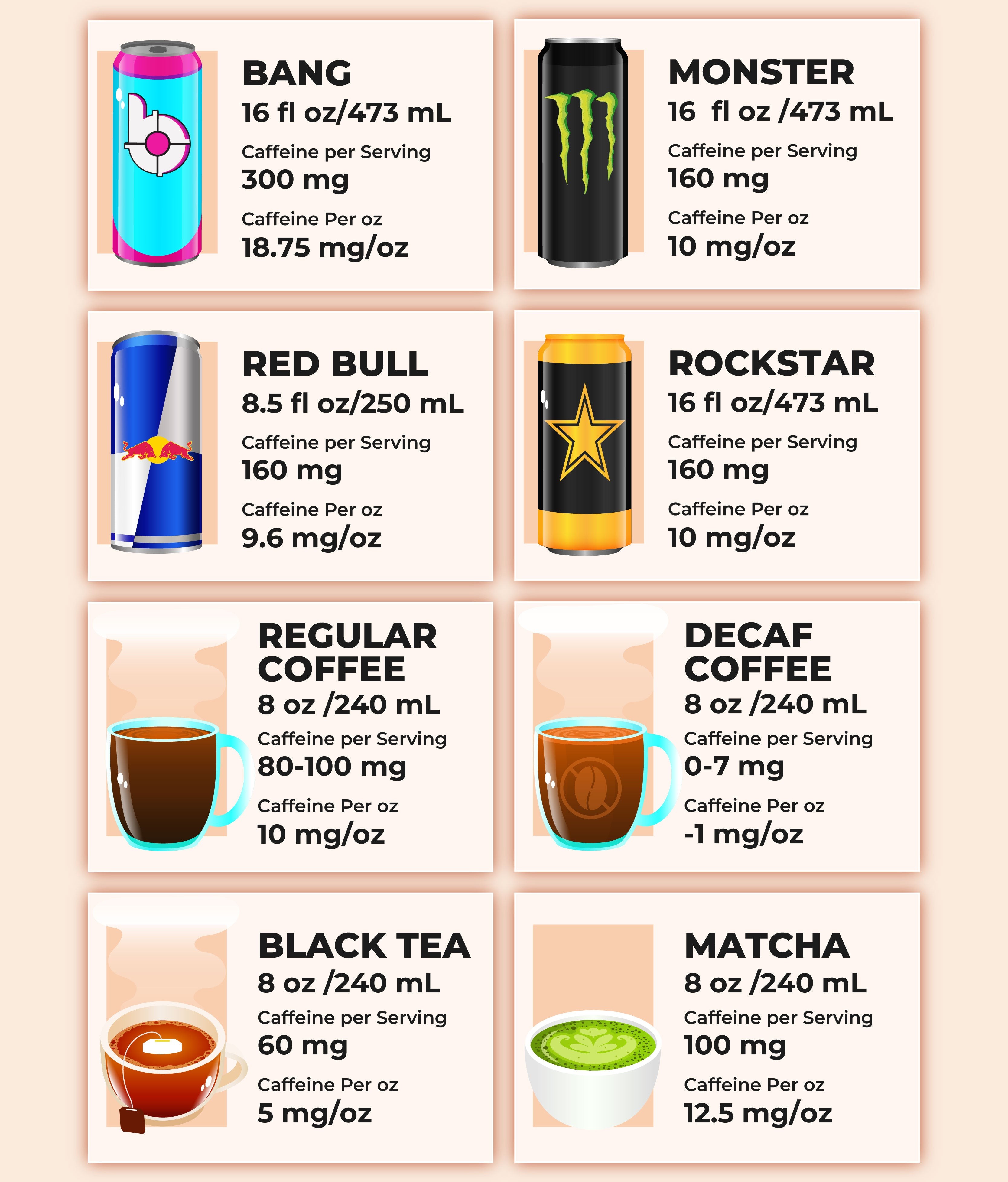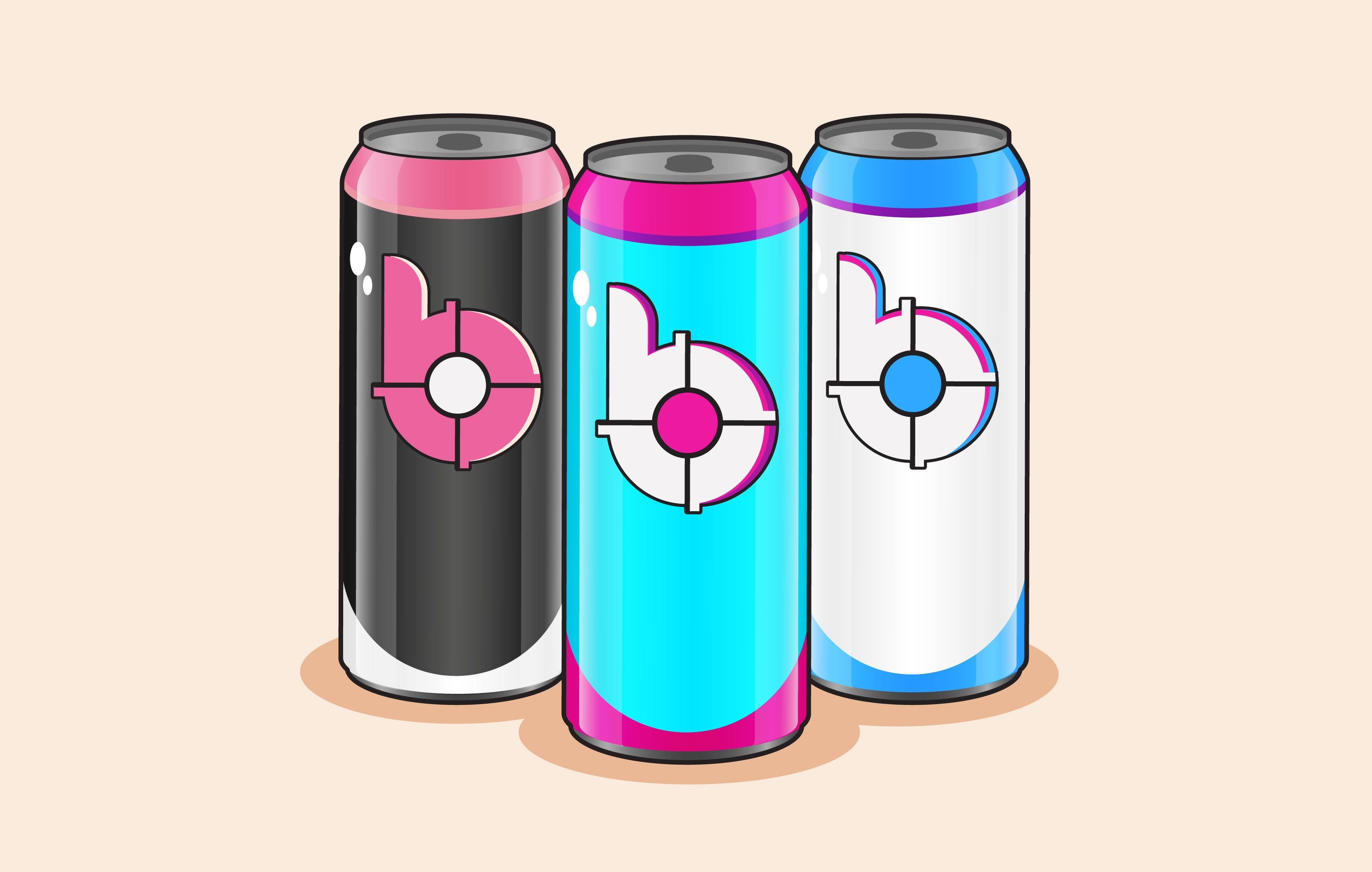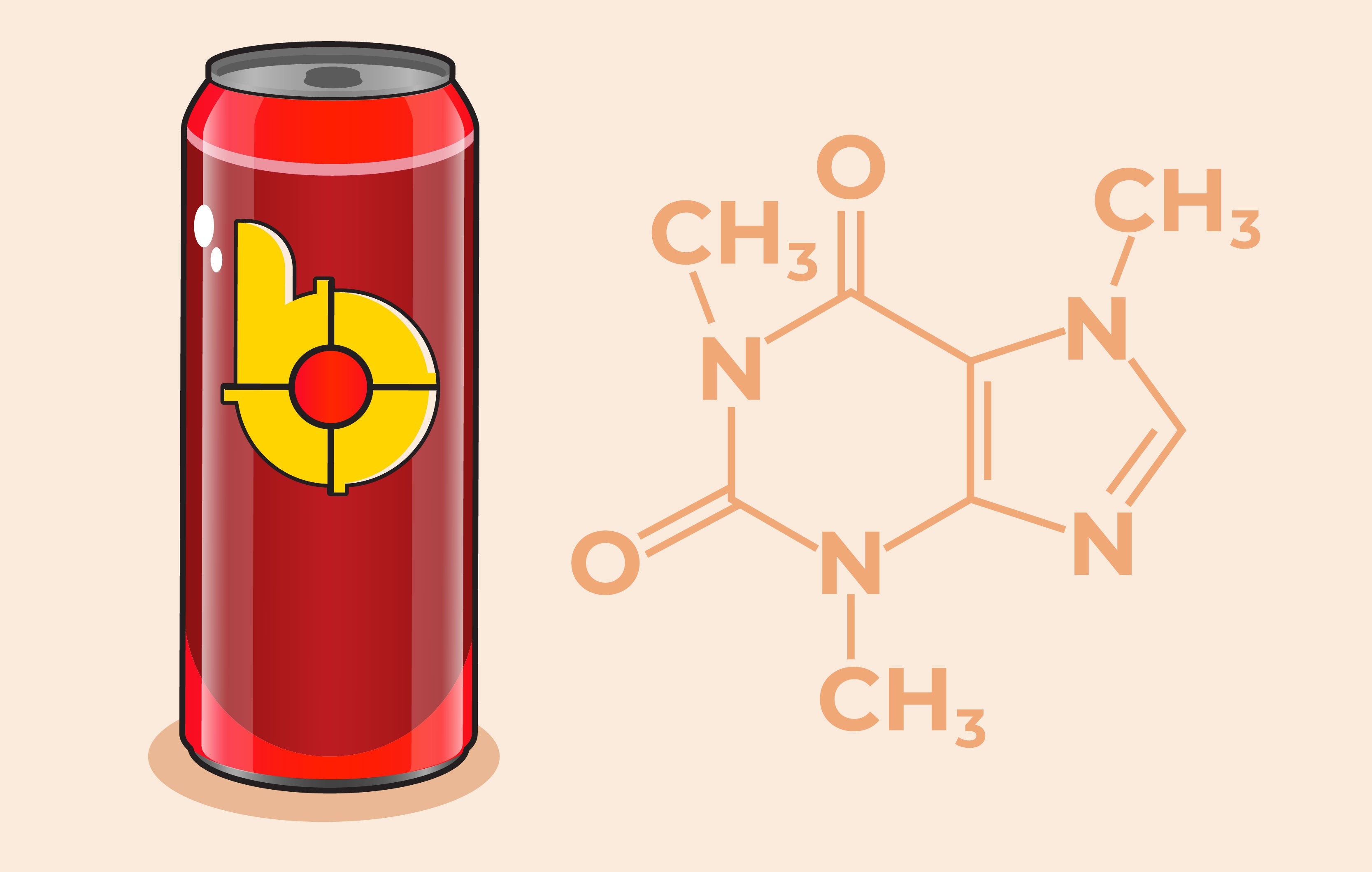Are you curious about the caffeine content in a Bang energy drink versus a cup of coffee? COMPARE.EDU.VN breaks down the caffeine levels, potential health effects, and better alternatives to help you make an informed choice. We offer a detailed comparison, examining the pros and cons of each, ensuring you have the facts to decide what’s best for you. Uncover insights on anhydrous caffeine, daily intake recommendations, and potential side effects, empowering you to make smarter, healthier decisions about your caffeine consumption.
1. Understanding Caffeine Levels: Bang Energy vs. Coffee
Bang energy drinks are popular for their high caffeine content, marketed to boost energy, physical performance, and mental alertness. Each can contains a significant 300 mg of caffeine. This is substantially more than other caffeinated beverages.
1.1. How Much More Caffeine Does Bang Have Compared to Coffee?
A can of Bang contains over three times the caffeine levels found in an average cup of coffee. The typical cup of coffee contains around 95 mg of caffeine, while a single can of Bang boasts 300 mg.
1.2. A Detailed Comparison of Caffeine Content
To put it into perspective, here’s a comparison of caffeine levels in various popular caffeinated beverages:
| Beverage | Caffeine Content (Approximate) |
|---|---|
| Bang Energy Drink | 300 mg |
| Average Cup of Coffee (8 oz) | 95 mg |
| Espresso (1 oz) | 63 mg |
| Black Tea (8 oz) | 47 mg |
| Green Tea (8 oz) | 28 mg |
| Coca-Cola (12 oz) | 34 mg |



This table highlights the stark difference in caffeine concentration between Bang energy drinks and other common sources of caffeine.
2. The Science Behind the Caffeine: Anhydrous Caffeine Explained
Energy drinks, like Bang, provide a jolt by using caffeine to block adenosine, a neurotransmitter that promotes sleep. This process enhances alertness and reduces fatigue.
2.1. What is Anhydrous Caffeine?
Most energy drinks, including Bang, utilize anhydrous caffeine, which is a semi-synthetic form of the stimulant. It’s extracted from coffee plant seeds and leaves but refined in a lab to create a highly concentrated form.
2.2. The Potency of Anhydrous Caffeine
Anhydrous caffeine is incredibly potent. Just one teaspoon of this refined chemical is equivalent to approximately 28 cups of coffee. This extreme concentration is what makes energy drinks like Bang so effective—and potentially risky.
3. Understanding Health Implications: High Caffeine Consumption
According to the Food and Drug Administration (FDA), a safe daily caffeine intake for most healthy adults is up to 400 mg. Exceeding this limit can lead to several adverse health effects.
3.1. Safe Caffeine Limits:
Here’s what 400 mg of caffeine roughly equates to:
- 4 to 5 cups of coffee
- 8 cups of tea
- 2 standard energy drinks
3.2. Potential Risks of High Caffeine Intake
Drinking more than one can of Bang per day could expose you to adverse health effects, including:
- Anxiety or Nervousness: Triggered by adrenaline release.
- Jitteriness: Excessive stimulation causing physical agitation.
- Insomnia: Difficulty falling asleep or waking up too early.
- Diarrhea or Vomiting: Primarily due to caffeine’s laxative properties.
- Addiction: Psychological or physical dependency.
- High Blood Pressure: Stimulation of the nervous system.
- Heart Palpitations and Chest Pains: Especially common in young people.
- Withdrawal Fatigue: Experiencing a crash as caffeine wears off.
- Frequent Urination: Caffeine is a known diuretic.
- Headache, Dizziness, or Delirium: Interference with circulation and blood vessels in the brain.
If you experience any of these symptoms after consuming caffeinated beverages, it’s crucial to seek immediate medical attention.
4. Who Should Avoid Bang Energy Drinks? Important Guidelines
Bang Energy explicitly states that its products are not recommended for children, pregnant or nursing women, or individuals sensitive to caffeine. Certain pre-existing conditions also warrant caution.
4.1. Conditions to Consider
Avoid Bang Energy drinks if you suffer from conditions such as:
- Anxiety
- Bipolar disorder
- Bleeding disorders
- Heart conditions
- Diabetes
- Epilepsy
- Glaucoma
- High blood pressure
- Parkinson’s disease
- Schizophrenia
4.2. Individual Tolerance Levels
It’s important to remember that the FDA’s recommended daily intake is just a guideline. Everyone has unique tolerance levels, and you should never consume more caffeine than you can safely handle.
5. The Bang Energy Story: A Look at Its Evolution
Introduced in 2012, Bang Energy quickly rose to become the fourth-highest-selling energy drink in 2023. However, the company faced setbacks when its CEO made unsubstantiated claims about the beverages’ ability to cure neurological disorders.
5.1. Legal Troubles and Bankruptcy
Following a multimillion-dollar lawsuit from Monster, Bang Energy declared bankruptcy in 2023 and was subsequently acquired by its competitor.
5.2. Product Line Changes
The company previously offered a wide range of products like Bang Keto Coffee and Bang Natural, but these have since been discontinued.
6. What Do Users Say? Analyzing Consumer Reviews of Bang Energy Drinks
Bang Energy drinks are popular, with over 47 million cases sold in 2021. However, consumer reviews are mixed. Social conversations around Bang Energy decreased significantly from 2023 to 2024, partly due to a preference for healthier beverage options.
6.1. Varying Opinions
Rankings of the “most popular flavor” vary widely, although Black Cherry Vanilla often appears near the top. Currently, there are 12 flavors to choose from, ranging from Peach Mango to Rainbow Unicorn.
6.2. The Keto Diet Connection
Bang energy drinks have found a place in the keto diet, appealing to consumers looking for sugar-free energy boosts. This connection has contributed to their popularity.
7. Exploring Alternatives: Lower-Caffeine Energy Boosts
If Bang’s high caffeine content concerns you, several lower-caffeine alternatives can provide a healthier energy boost.
7.1. Traditional Coffee
Options like Cafely OG SaiGon, a dark-roast coffee blend of arabica, robusta, and peaberry, offer a rich flavor and natural energy boost with less caffeine than Bang.
7.2. Black Tea
Provides the benefits of caffeine without the excessive amounts found in energy drinks.
7.3. Kombucha
A fermented drink with B vitamins that delivers a gentle energy lift. It contains only 10-15 mg of caffeine per 8oz serving.
7.4. Coconut Water
Rich in electrolytes that replenish and boost energy levels, plus it’s caffeine-free.
7.5. Protein Shakes
Excellent post-workout beverages that replenish nutrients and provide a natural energy boost.
8. FAQs: Addressing Common Concerns About Bang Energy Caffeine Content
Here are some frequently asked questions about the caffeine content in Bang Energy Drinks:
8.1. How much more caffeine is in a Bang Energy drink compared to coffee?
A can of Bang contains approximately three times as much caffeine as an average cup of coffee.
8.2. Is it safe to drink Bang Energy drinks every day?
While a single can may fall under the FDA’s recommended daily caffeine intake, daily consumption is not advised for everyone, especially over extended periods.
8.3. Can Bang Energy drinks cause caffeine overdose?
Yes, consuming multiple cans in a short time or even within a single day can lead to caffeine overdose.
8.4. Are there any caffeine-free versions of Bang?
No, all Bang Energy drinks contain the same high caffeine amount.
8.5. How does Bang’s high caffeine content affect workout performance?
Bang can increase alertness and energy, potentially improving workout intensity.
8.6. Is Bang suitable for children?
No, Bang energy drinks are not recommended for children due to their high caffeine content.
8.7. Is Bang suitable for adults?
Bang Energy drinks are not recommended for pregnant or nursing women or those with caffeine sensitivity.
8.8. How does Bang’s caffeine content compare to other energy drinks?
Bang Energy drinks generally have a higher caffeine content than most other energy drinks on the market.
8.9. Can Bang Energy drinks help you lose weight?
Although often marketed as a weight loss aid, energy drinks are often associated with poor weight loss behaviors and unhealthy body image.
8.10. What are some natural alternatives to Bang?
Natural coffee blends, like Cafely Sai Gon OG, have lower caffeine levels and are a healthier, more natural alternative to energy drinks.
9. Choosing Wisely: Make Informed Decisions with COMPARE.EDU.VN
Understanding the caffeine content of Bang energy drinks compared to coffee is crucial for making informed decisions about your health. Whether you’re assessing workout performance, considering potential health risks, or seeking healthier alternatives, having accurate information is essential.
9.1. Making the Right Choice
At COMPARE.EDU.VN, we understand the importance of providing detailed, objective comparisons to help you make the right choice. Our aim is to offer clear insights into different products, services, and ideas, enabling you to assess their pros and cons effectively.
9.2. Ready to Explore More?
Ready to explore more comparisons and make informed decisions? Visit COMPARE.EDU.VN today to discover a wealth of resources designed to empower your choices.
Are you struggling to compare different options objectively? Do you feel overwhelmed by too much information? COMPARE.EDU.VN provides detailed, unbiased comparisons to simplify your decision-making process. From product features and specifications to user reviews and expert opinions, we offer comprehensive analyses to help you choose what’s best for you. Don’t let indecision hold you back. Visit compare.edu.vn now and make smarter, more informed decisions today. For further assistance, you can reach us at 333 Comparison Plaza, Choice City, CA 90210, United States, or contact us via Whatsapp at +1 (626) 555-9090. We are here to help you make the best choices!
10. References
- U.S. Department of Health and Human Services. (n.d.). Energy drinks. National Center for Complementary and Integrative Health. https://www.nccih.nih.gov/health/energy-drinks
- Ribeiro, J. A., & Sebastião, A. M. (2010). Caffeine and adenosine. Journal of Alzheimer’s Disease: JAD, 20 Suppl 1(20), S3-15. https://doi.org/10.3233/JAD-2010-1379
- Commissioner, O. of the. (n.d.). Spilling the beans: How much caffeine is too much? U.S. Food and Drug Administration. https://www.fda.gov/consumers/consumer-updates/spilling-beans-how-much-caffeine-too-much
- USDA. (2020). Dietary Guidelines For Americans. Ninth Edition. https://www.dietaryguidelines.gov/sites/default/files/2020-12/Dietary_Guidelines_for_Americans_2020-2025.pdf
- A;, M. A. S. A. (n.d.). Energy drinks and atrial fibrillation in young adults. Clinical nutrition (Edinburgh, Scotland). https://pubmed.ncbi.nlm.nih.gov/28527645/
- Higgins, J. P., Tuttle, T. D., & Higgins, C. L. (2010, November). Energy beverages: Content and safety. Mayo Clinic proceedings. https://www.ncbi.nlm.nih.gov/pmc/articles/PMC2966367/
- EG;, J. A. H. K. (n.d.). Energy Drinks, weight loss, and disordered eating behaviors. Journal of American College Health : J of ACH. https://pubmed.ncbi.nlm.nih.gov/24635529/